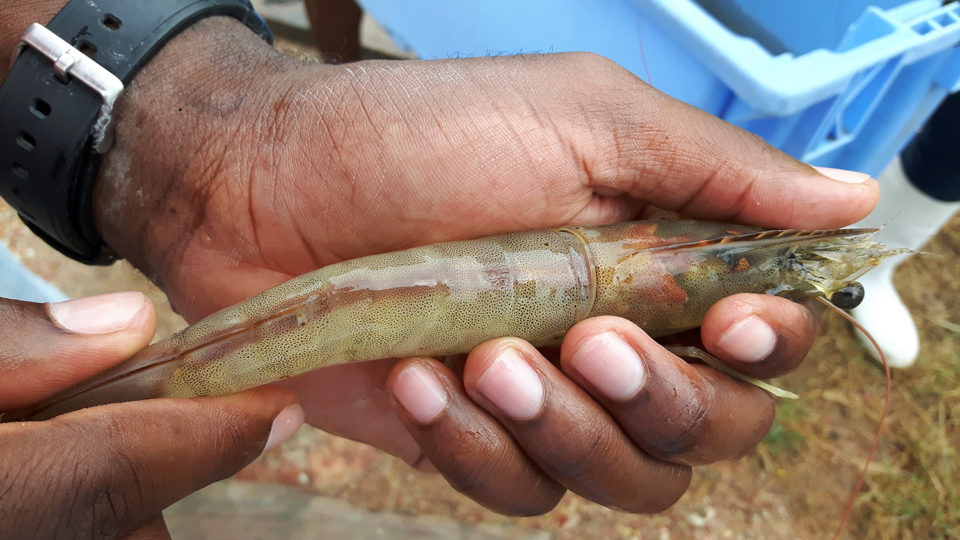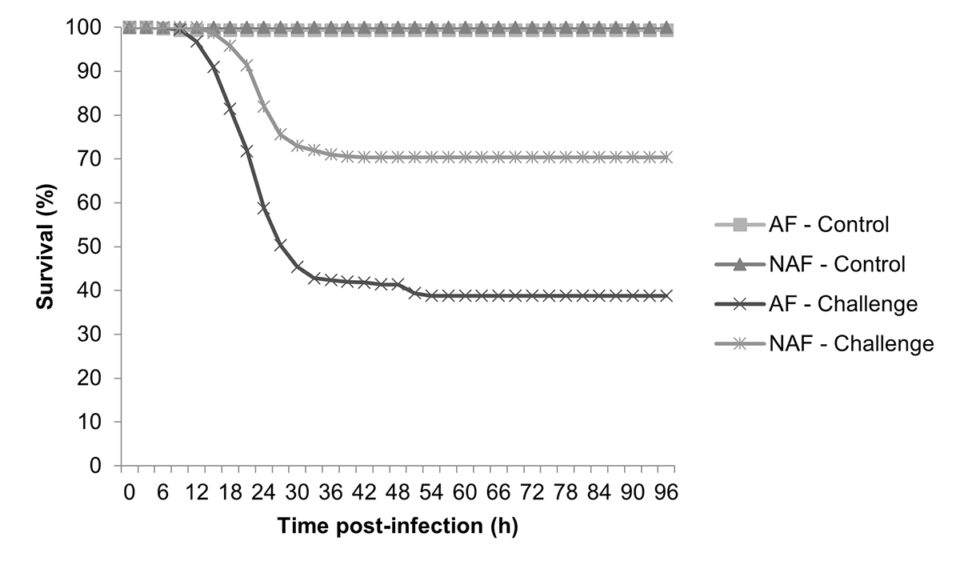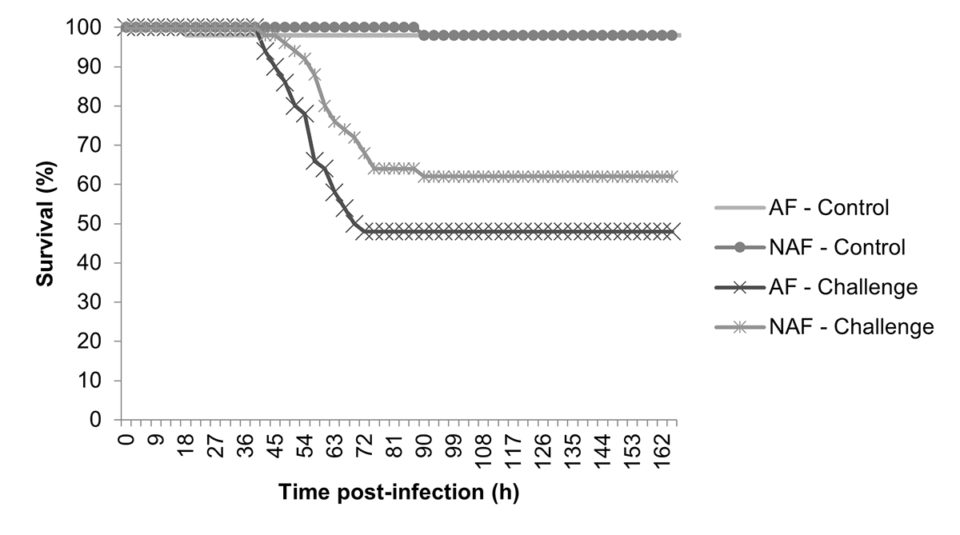Progeny from non-ablated females more robust when challenged with Acute Hepatopancreatic Necrosis Disease and White Spot Disease

The global shrimp farming industry is affected by regular episodes of diseases like Acute Hepatopancreatic Necrosis Disease (AHPND) – commonly referred to as Early Mortality Syndrome (EMS) – and White Spot Disease (WSD). These episodes can result in catastrophic crop failures with consequential severe financial losses. Finding ways to reduce the impact of diseases and ensure high rates of survival has long been a key industry objective.
Eyestalk ablation of shrimp female broodstock remains a standard practice in most hatcheries worldwide but it has been increasingly criticized for its impact on welfare, broodstock condition (nutritional and/or physiological status) and on the quality of offspring produced (e.g. postlarvae, or PLs).
The resistance or tolerance of shrimp seedstock to disease challenges in farms, in part, depends on broodstock quality and genetics. Theoretically, non-ablated females should demonstrate better overall condition than ablated animals as the latter have higher exposure to physical trauma, stress, physiological imbalance and activation/reduction of immune related genes as a consequence of ablation.
The health of broodstock may consequentially be reflected on the quality of their offspring. Producing Pacific white shrimp (Litopenaeus vannamei) postlarvae and juveniles from high welfare, non-ablated females in commercial hatcheries could result in significant increases in the survival of animals, particularly during periods when they are under stress (e.g. during the early phase of pond culture) or, more critically, when faced with exposure to pathogens like Vibrio parahaemolyticus, causing AHPND and/or White Spot Syndrome Virus (WSSV), causing WSD.
Editor’s note: Dr. Zacarias’ research won the 2020 Global Aquaculture Innovation Award:
https://www.aquaculturealliance.org/advocate/innovation-award-2020-finalist-simao-zacarias-shrimp-eyestalk-ablation-research/
The authors would like to thank Labeyrie Fine Foods, Benchmark Animal Health, SyAqua Siam and the Global Aquaculture Alliance for playing key roles in this innovative research; and Seajoy Cooke for supporting initial works on shrimp broodstock non-ablation, which led to this research.
Study setup
We conducted research trials in Thailand to explore this study hypothesis using L. vannamei postlarvae originating from a single population of female broodstock from SyAqua Siam, half of which were ablated and half non-ablated. The postlarvae (PLs) produced were subsequently transferred to Benchmark’s R&D (Thailand) for testing.
For the AHPND challenge tests, groups of 100 PLs (average weight 14 mg) from either ablated or non-ablated females were placed in 20-liter tanks. Five replicates were stocked per condition (ablated or non-ablated) and water maintained at 15 ppt and 29.05 ± 0.13 degrees-C. The PLs were exposed to 2.0 × 108 CFU/ml of a pathogenic isolate of Vibrio parahaemolyticus (VpAHPND) and then checked every three hours over the subsequent 96 hours.
The WSD challenges tests were carried out with juveniles (average weight 1.42 ± 0.07 grams) held individually in 1-liter vessels (50 replicates per condition). Salinity and temperature were maintained at 15 ppt and 26.33 ± 0.73 degrees-C, respectively. Oral challenges were done by feeding a 0.1-gram ration of WSSV-infected L. vannamei tissue (average 2.02 × 109 WSSV per ration) and the shrimp monitored every three hours over the subsequent 162 hours. For full details relating to the experimental challenges, refer to Zacarias, S. et al. (2020) Aquaculture, 552: 736033 (https://doi.org/10.1016/j.aquaculture.2020.736033).
Results and discussion
The AHPND challenge showed that PLs from ablated females had significantly (p = <1.3E-36) lower survival (38.8 percent) than those from non-ablated females (70.4 percent) (Fig. 1). Juveniles originating from non-ablated animals also had higher, but not significantly so (p>0.05) survival (62 percent) than those from ablated females (48 percent) when challenged with WSD (Fig. 2).


The results clearly suggest that the negative impacts of ablation could be carried over and affect the health or fitness of the offspring. Negative impacts of maternal health and nutrition on their offspring have been reported previously in fish. These results suggest that the stresses associated with ablation have a similar effect on shrimp, although the underlying mechanisms are not yet understood.
The industry has used unilateral eyestalk ablation for decades to ensure a steady supply of nauplii for the hatchery and nursery phases of production. It is widely believed that ablation increases the frequency, productivity and consistency of nauplii production. The practice of ablation, however, has come under increasing scrutiny by retailers and consumers, threatening market access.
Results of this study show that ablation can also carry hidden negative costs through reduced ability of PLs and juveniles to survive disease challenges. These costs (and losses) may not be evident until the PLs are stocked in farms. Hatcheries operating without ablation may have to stock additional females to compensate, although previous tests showed that nauplii production rates could be maintained through improved management and feeding regimes.
Our innovative research addressed key welfare concerns of unilateral eyestalk ablation, antibiotic and chemical usage in shrimp production, and the management and control of shrimp diseases. Offspring from non-ablated female are more resistant to commonly encountered diseases, meaning higher rates of stock survival and reduced demand for expensive (and often ineffective) treatments. This approach reduces the probability of financial losses, contributing to the sustainability of the industry and, critically for small scale farmers, ensuring shrimp farming is a viable livelihood option.
Perspectives
The breakthrough findings in our study can be expected to become a key health strategy in shrimp farming going forward. Shrimp hatcheries switching to a non-ablation-based system would produce robust animals which may command a higher price based on quality and welfare.
In the future, farmers could insist on animals from non-ablated broodstock as part of a holistic biosecurity and management strategy, thus improving productivity during disease outbreaks without resorting to more costly and less effective treatments.
Now that you've finished reading the article ...
… we hope you’ll consider supporting our mission to document the evolution of the global aquaculture industry and share our vast network of contributors’ expansive knowledge every week.
By becoming a Global Seafood Alliance member, you’re ensuring that all of the pre-competitive work we do through member benefits, resources and events can continue. Individual membership costs just $50 a year. GSA individual and corporate members receive complimentary access to a series of GOAL virtual events beginning in April. Join now.
Not a GSA member? Join us.
Authors
-

Simão Zacarias, Ph.D.
Corresponding author
Institute of Aquaculture
University of Stirling
Stirling FK9 4LA, Scotland, UK -
Daniel Fegan
SyAqua Siam Co., Ltd., Diagnostic Laboratory
733/8 M. 8, Phahon Yothin Soi 80, Phahon Yothin Rd.
Khu Khot, Lam Luk Ka, Pathumthani 12130, Thailand -
Siriroj Wangsoontorn, Ph.D.
SyAqua Siam Co., Ltd., Diagnostic Laboratory
733/8 M. 8, Phahon Yothin Soi 80, Phahon Yothin Rd.
Khu Khot, Lam Luk Ka, Pathumthani 12130, Thailand -
Nitrada Yamuen, MSc.
Benchmark R&D (Thailand) Ltd.
No 57/1, Moo 6, Samed, Muang Chonburi
Chonburi 20000, Thailand -
Tarinee Limakom, MSc.
Benchmark R&D (Thailand) Ltd.
No 57/1, Moo 6, Samed, Muang Chonburi
Chonburi 20000, Thailand -
Andrew Davie, Ph.D.
Institute of Aquaculture
University of Stirling
Stirling FK9 4LA, Scotland, UK -
Stefano Carboni, Ph.D.
Institute of Aquaculture
University of Stirling
Stirling FK9 4LA, Scotland, UK -
Matthijs Metselaar, DVM, Ph.D.
Benchmark Animal Health
Bush House, Edinburgh Technopole
Edinburgh EH26 0BB, UK -

David C. Little, Ph.D.
Institute of Aquaculture
University of Stirling
Stirling FK9 4LA, Scotland, UK -
Andrew P. Shinn, Ph.D.
Institute of Aquaculture
University of Stirling
Stirling FK9 4LA, Scotland, UK; and
Benchmark R&D (Thailand) Ltd.
No 57/1, Moo 6, Samed, Muang Chonburi
Chonburi 20000, Thailand; and
Benchmark Animal Health
Bush House, Edinburgh Technopole
Edinburgh EH26 0BB, UK
Tagged With
Related Posts

Innovation & Investment
Innovation Award 2020 finalist: Simao Zacarias’ shrimp eyestalk ablation research
Farmed shrimp eyestalk ablation research is one of three finalists for the Global Aquaculture Alliance’s annual Global Aquaculture Innovation Award.

Health & Welfare
Stirling researcher preps eyestalk-ablation alternative trials
University of Stirling Ph.D. student Simão Zacarias, who is from is Beira, Mozambique, will soon travel to Isla del Tigre, Honduras, to document evidence showing the benefits of breeding shrimp without eyestalk ablation. His is a journey of hopeful discovery.

Health & Welfare
Reproductive performance of L. vannamei broodstock reared in ponds and tanks
Research compares differences in female reproductive performance for Pacific white shrimp broodstock reared in earthen ponds and recirculating tanks.

Health & Welfare
Study ties animal welfare practices to consumer purchasing
There’s an opportunity to expand the U.S. market for farmed seafood if the aquaculture industry were to more widely adopt humane production practices, according to a study by Changing Tastes and Datassential.


